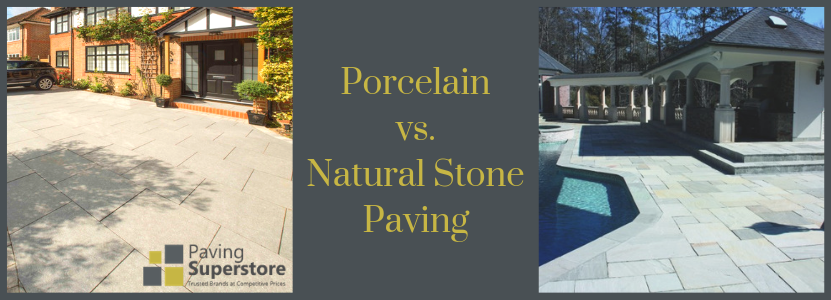

Porcelain and natural stone paving boast distinct advantages, so which is better? If you’re keen to get started with your landscaping project - but simply can’t decide - we at Paving Superstore are ready to weigh in and help you make up your mind. In this blog, we’re considering how porcelain stacks up against natural stone in terms of durability, versatility, and the different ranges available within each.
Porcelain vs Stone Paving: Construction
Porcelain paving is extremely versatile, and while it has a reputation as a premium option, its long life means that it ends up being quite an economical choice in the long term. Ideal for exterior walkways, porches, and patios, porcelain is created in the oven as clay is treated via specialist printing processes to resemble natural timber or stone. The resulting slab or tile is a very attractive pattern that will work well both indoors and outdoors.
In contrast to natural stone slabs, tiles, or paving, porcelain flooring and walling is resistant to fading and requires very little additional treatment once the tiles themselves have been created. This makes them intensely durable for their lightweight construction.
Paving made from natural stone is just that--natural. It can include granite, basalt, limestone, sandstone, or any number of gorgeous rocks that are typically quarried and very strong. The main shortcoming of natural stone paving lies in its tendency to show natural characterics, some of which are desirable whereas others may be considered as unsightly by some people. Some stone such as black limestone will gradually fade in sunlight.
So, what about the other pros and cons of porcelain and natural stone?
Resistance to Staining
Whether it’s puddles from the pool or sloshed tea, moisture stains create unsightly blemishes on your paving. In general, porcelain pavers like our Paving Superstore Porcelain 'Select Range' Aosta White PAVING SLABS are less absorbent and porous than natural stone, staining less readily. When a water mark is left behind, it tends to be smaller and less visible than it would be on natural stone. It's always a good idea to remove leaves and other debris from the surface of paving as it will stain, even just temporarily.
Gauge and Density
If you’re looking for a thinner, lighter slab, porcelain is on the whole less thick than stone paving options like limestone, granite, or sandstone. The average thickness of most external porcelain paving slabs ranges between 15 mm and 20 mm, with some slight variation on either side. This makes pavers such as the Brett Eclipse Collection slabs much more versatile in terms of both indoor and outdoor usage - they are stunning as kitchen, bathroom, and patio flooring, lending themselves to an airy atmosphere and opening up interior spaces to natural light. Stone pavers, in contrast, are ideal for utility areas and heavy-duty floorings such as in workshops and sheds.
Ease of Installation
Thanks to their lightweight nature, porcelain pavers are quicker and easier to lay than stone slabs, helping to reduce the cost and effort of installation in most cases. They are also less costly to transport over large distances and can be more eco-friendly as a result, contributing to lower fossil fuel consumption. The Global Stone Six Series collection, for example, is full of delightfully lightweight tiles that are simple even for the first-time DIY-er to lay! Ensure you use slury primer to the reverse of porcealin to aid adhesion.
Scratching and Slipping
Compared to natural stone, porcelain has a smoother, finer-grained surface and is less slip-resistant. It is perfect for creating even, smooth flooring and finishes, being more resistant to scratching and abrasion - but gets a little more slippery when exposed to moisture. Around the poolside or as garden edging, both options of paving may be a practical choice, but check the slip ratings for the best options on each individual product.
At the end of the day, the perfect garden paving will depend on how you love to use your outdoor living area. Both porcelain and natural stone offer a combination of unique pros and cons and a wonderful balance of functionality and style. They can absolutely be used together in one space to contrast and complement each other to great effect.
So which do you prefer?

